I did not know that. Interesting.yeah, and I've found that keeping them under Passive Stance helps them survive an encounter with the RN. well, most of the time anyway.
The German Reich and the Second World War
- Thread starter enigmamcmxc
- Start date
-
We have updated our Community Code of Conduct. Please read through the new rules for the forum that are an integral part of Paradox Interactive’s User Agreement.
You are using an out of date browser. It may not display this or other websites correctly.
You should upgrade or use an alternative browser.
You should upgrade or use an alternative browser.
Battle for Estonia (10 Nov 1942 – 19 Jan 1943)
After several weeks of preparation, realigning troops and bringing up reinforcements, the Battle for Estonia began on 10 November. The Soviets had not sat ideally-by awaiting an attack, and had not been drawn south by the heavy fighting raging for Odessa. An estimated 15 divisions had been assembled, and had taken the time to dig in as the temperature dropped below freezing and snow covered the battlefield.
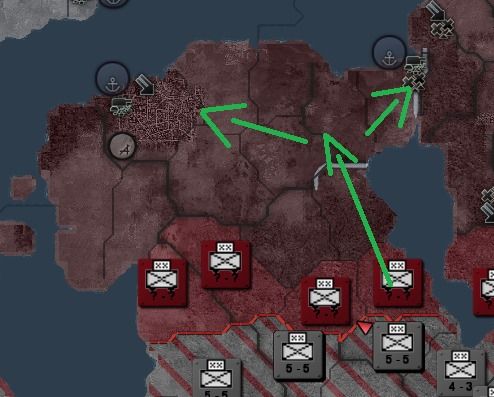
The original battle plan.
The initial plan called for a breakthrough along the coast of Lake Peipus, then a panzer thrust north to cut off the Red Army in Estonia. The attack would aim to capture the forts guarding the pass between the lake and the sea, thus creating a shorter front to defend in the future. Tallinn would then be captured and the various Soviet forces rounded up. On the morning of 10 November, as snow blew across the Estonian forests, bombers and artillery blasted the Soviet frontline and infantry moved forward to assault. Everything, however, was against our assaulting infantry. A maturing Red Army, dug-in positions, the forests, and the climate, resulted in the initial attacks incurring horrific losses. The first wave was brought to a bloody stop without putting anywhere near a dent in the Soviet defenses.
After several days the attack was called off, and was followed by a broad assault across the length of the front to try and find a weak spot. These attacks too proved costly and gained nothing. After several days of pointless fighting, these too were halted. The breakthrough had been expected to be achieved within a week, per all the other operations fought thus far, and now the operation was two weeks behind schedule with little to show for the loss of men. In a change to the original plan, the weight of our forces was shifted to strike at the center of the Soviet positions. Rotating divisions in and out of the battle, the Red Army – unable to rotate or reinforce – was slowly ground down. Finally, in the first week of December, the center of the frontline snapped and the panzers were ordered forward. Heavy losses had been incurred, and several divisions were now several thousand men short of their establishment. As the frontline was pierced, a second effort to take Odessa began.
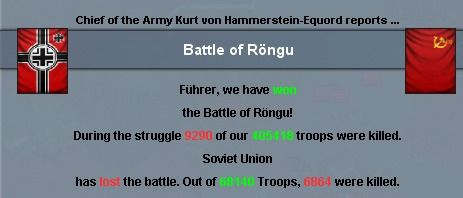
The Battle of Rongu: the point where the breakthrough began.
The panzer divisions surged north, before spreading out. The Grossdeutschland Division, in its first battle, launched an attack on Tallinn from the south while panzer divisions reached the northern coast and attacked from the east. The panzer drive to the northeast – aimed at capturing the pass between the coast and Lake Peipus - was blocked and led to a prolonged bloody battle. A western attack by the panzers cut off frontline Soviet forces, but was blocked from forming another wing of the attack on the Estonian capital due to Red Army counterattacks.
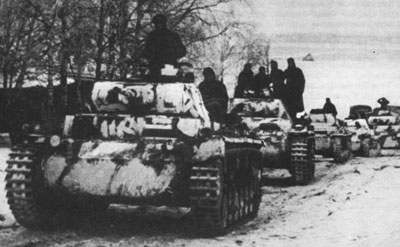
Panzers advancing in Estonia.
On 5 January, the Second Battle of Odessa came to an end. Snow had fallen all over the southern front and the temperatures there too had dropped below freezing. It was in this climate that 26,000 German lives were lost in a futile attempt to take the city. With so many lives lost, it was decided to await reinforcements and perhaps better weather before retrying.

The anti-comintern pact grows.
In Estonia, during the course of the month the Red Army was worn down. The positions, which had once been the frontline, were surrounded and after much fighting destroyed one by one. The attempts to push the new frontline further east were blocked by determined Soviet reinforcements, but the Red Army was not able to successfully counterattack and save their comrades within Estonia. A small number of Soviet troops were able to flee onto the archipelago of islands off the coast, and resisted the first German attempt to land on the island. The main battle, the fighting for Tallinn, carried on until 19 January. That day, the Soviet garrison laid down their arms and surrendered. The capture of the city garrison brought the total number of prisoners, taken during the fight for Estonia, to a total of 131,586. Our forces had lost just under 50,000 men during the battle, and the best possible estimates suggested Soviet losses were close to 60,000. The battle for Estonia had not been the walkover that had been expected, and had dragged on a lot longer than anticipated. With the major fighting over, the redeployment of forces could now begin. Von Hammerstein-Equord, after much consultation with his staff earlier in the year, had planned for a major campaign to take place in the Ukraine during 1943. As a result, Army Group North would be drastically weakened over the coming months. Von Both, commanding officer of Army Group North, would therefore have to rapidly fight several costly winter battles, against an estimated 16 divisions, to achieve the main objective of Narva before his force became a static army group unable of launching an offensive.

Fresh from France, garrison troops march into Tallinn following the battle
and are welcomed by the population glad to be rid of the Soviets.
While the outskirts of the city had been heavily damaged, the center had not.
After several weeks of preparation, realigning troops and bringing up reinforcements, the Battle for Estonia began on 10 November. The Soviets had not sat ideally-by awaiting an attack, and had not been drawn south by the heavy fighting raging for Odessa. An estimated 15 divisions had been assembled, and had taken the time to dig in as the temperature dropped below freezing and snow covered the battlefield.

The original battle plan.
The initial plan called for a breakthrough along the coast of Lake Peipus, then a panzer thrust north to cut off the Red Army in Estonia. The attack would aim to capture the forts guarding the pass between the lake and the sea, thus creating a shorter front to defend in the future. Tallinn would then be captured and the various Soviet forces rounded up. On the morning of 10 November, as snow blew across the Estonian forests, bombers and artillery blasted the Soviet frontline and infantry moved forward to assault. Everything, however, was against our assaulting infantry. A maturing Red Army, dug-in positions, the forests, and the climate, resulted in the initial attacks incurring horrific losses. The first wave was brought to a bloody stop without putting anywhere near a dent in the Soviet defenses.
After several days the attack was called off, and was followed by a broad assault across the length of the front to try and find a weak spot. These attacks too proved costly and gained nothing. After several days of pointless fighting, these too were halted. The breakthrough had been expected to be achieved within a week, per all the other operations fought thus far, and now the operation was two weeks behind schedule with little to show for the loss of men. In a change to the original plan, the weight of our forces was shifted to strike at the center of the Soviet positions. Rotating divisions in and out of the battle, the Red Army – unable to rotate or reinforce – was slowly ground down. Finally, in the first week of December, the center of the frontline snapped and the panzers were ordered forward. Heavy losses had been incurred, and several divisions were now several thousand men short of their establishment. As the frontline was pierced, a second effort to take Odessa began.

The Battle of Rongu: the point where the breakthrough began.
The panzer divisions surged north, before spreading out. The Grossdeutschland Division, in its first battle, launched an attack on Tallinn from the south while panzer divisions reached the northern coast and attacked from the east. The panzer drive to the northeast – aimed at capturing the pass between the coast and Lake Peipus - was blocked and led to a prolonged bloody battle. A western attack by the panzers cut off frontline Soviet forces, but was blocked from forming another wing of the attack on the Estonian capital due to Red Army counterattacks.

Panzers advancing in Estonia.
On 5 January, the Second Battle of Odessa came to an end. Snow had fallen all over the southern front and the temperatures there too had dropped below freezing. It was in this climate that 26,000 German lives were lost in a futile attempt to take the city. With so many lives lost, it was decided to await reinforcements and perhaps better weather before retrying.

The anti-comintern pact grows.
In Estonia, during the course of the month the Red Army was worn down. The positions, which had once been the frontline, were surrounded and after much fighting destroyed one by one. The attempts to push the new frontline further east were blocked by determined Soviet reinforcements, but the Red Army was not able to successfully counterattack and save their comrades within Estonia. A small number of Soviet troops were able to flee onto the archipelago of islands off the coast, and resisted the first German attempt to land on the island. The main battle, the fighting for Tallinn, carried on until 19 January. That day, the Soviet garrison laid down their arms and surrendered. The capture of the city garrison brought the total number of prisoners, taken during the fight for Estonia, to a total of 131,586. Our forces had lost just under 50,000 men during the battle, and the best possible estimates suggested Soviet losses were close to 60,000. The battle for Estonia had not been the walkover that had been expected, and had dragged on a lot longer than anticipated. With the major fighting over, the redeployment of forces could now begin. Von Hammerstein-Equord, after much consultation with his staff earlier in the year, had planned for a major campaign to take place in the Ukraine during 1943. As a result, Army Group North would be drastically weakened over the coming months. Von Both, commanding officer of Army Group North, would therefore have to rapidly fight several costly winter battles, against an estimated 16 divisions, to achieve the main objective of Narva before his force became a static army group unable of launching an offensive.

Fresh from France, garrison troops march into Tallinn following the battle
and are welcomed by the population glad to be rid of the Soviets.
While the outskirts of the city had been heavily damaged, the center had not.
Last edited:
1942 in summary
With the capture of Tallinn, Operation "Wilhelm" and the 1942 campaign came to an end. It had failed to achieve the, what could be considered lofty, objective of capturing Leningrad and doing so in time to launch a second major offensive during 1942. The individual operations launched as part of this overall project, had met mixed success. Operation "Hoffmann" had inflicted considerable damage to the southern Soviet frontline, but its strategic influence on the Red Army deployments had been more than questioned. Operation "Ludendorff" proved to be a costly failure, and failed to achieve any of its strategic or territorial objectives. Finally, Operation "Hindenburg" had only achieved one of its major objectives: Tallinn. However, the operation had shortened the frontline and thus freed up troops for other operations, one of its primary strategic goals.
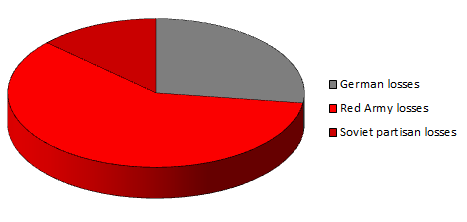
The difference in casualties.
In comparison to Operation Barbarossa, the fighting of 1942 had achieved modest territorial gains for increased casualties. 327,000 men had been killed, and a further 10,000 captured. The damage inflicted upon the Red Army had also not been as extensive as the previous year. During 1941 over one million casualties had been inflicted, during 1942 this fell by 300,000. The Red Army, as a result of the various operations, lost 534,000 men killed during 1942 and at least a further 207,805 had been taken as prisoners, although total overall losses were unknown. The Red Army had proved to be a tough nut to crack, able to absorb the huge losses inflicted upon it and carry on fighting. More alarmingly, the defensive competency of the Soviet soldiers had greatly increased as had the overall skill of the Red Air Force. It was somewhat of a relief that the Red Army had not launched any real offensives, and this lack of attacking and inability to punch through our lines when they did, had led to the conclusion that the Red Army was perhaps nearing the extent of its resources.
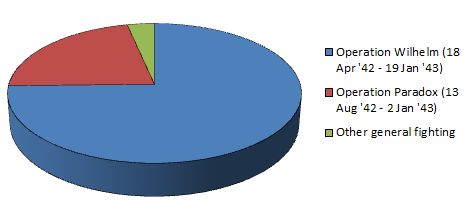
Soviet losses by operation.
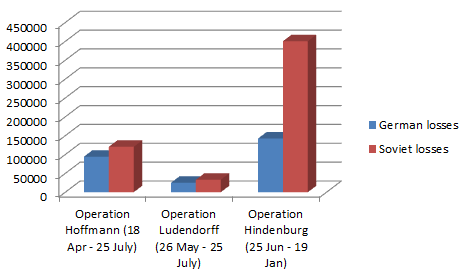
Breakdown of the casualties suffered and inflicted by each sub-operation of Operation Wilhelm.
While the frontline still needed to be tidied up, troops could now start to be redeployed for a major campaign in the Ukraine. The freeing up of resources would also allow the partisan problem, which had already resulted in over 160,000 deaths, to be remedied. The main objective for 1943 would be more modest than before: Kiev was to be taken, and the Dnieper Bend cleared.
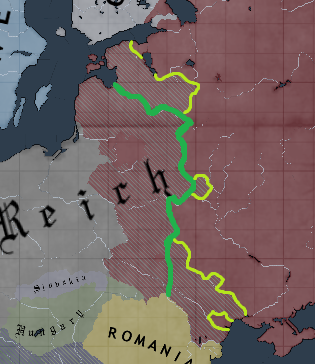
The frontline following the conclusion of fighting.
With the capture of Tallinn, Operation "Wilhelm" and the 1942 campaign came to an end. It had failed to achieve the, what could be considered lofty, objective of capturing Leningrad and doing so in time to launch a second major offensive during 1942. The individual operations launched as part of this overall project, had met mixed success. Operation "Hoffmann" had inflicted considerable damage to the southern Soviet frontline, but its strategic influence on the Red Army deployments had been more than questioned. Operation "Ludendorff" proved to be a costly failure, and failed to achieve any of its strategic or territorial objectives. Finally, Operation "Hindenburg" had only achieved one of its major objectives: Tallinn. However, the operation had shortened the frontline and thus freed up troops for other operations, one of its primary strategic goals.

The difference in casualties.
In comparison to Operation Barbarossa, the fighting of 1942 had achieved modest territorial gains for increased casualties. 327,000 men had been killed, and a further 10,000 captured. The damage inflicted upon the Red Army had also not been as extensive as the previous year. During 1941 over one million casualties had been inflicted, during 1942 this fell by 300,000. The Red Army, as a result of the various operations, lost 534,000 men killed during 1942 and at least a further 207,805 had been taken as prisoners, although total overall losses were unknown. The Red Army had proved to be a tough nut to crack, able to absorb the huge losses inflicted upon it and carry on fighting. More alarmingly, the defensive competency of the Soviet soldiers had greatly increased as had the overall skill of the Red Air Force. It was somewhat of a relief that the Red Army had not launched any real offensives, and this lack of attacking and inability to punch through our lines when they did, had led to the conclusion that the Red Army was perhaps nearing the extent of its resources.

Soviet losses by operation.

Breakdown of the casualties suffered and inflicted by each sub-operation of Operation Wilhelm.
While the frontline still needed to be tidied up, troops could now start to be redeployed for a major campaign in the Ukraine. The freeing up of resources would also allow the partisan problem, which had already resulted in over 160,000 deaths, to be remedied. The main objective for 1943 would be more modest than before: Kiev was to be taken, and the Dnieper Bend cleared.

The frontline following the conclusion of fighting.
Last edited:
Reckon its time to hunker down until the temps warm back up. Then what will be your plan for the next series of offensives? Unless perhaps the Red Army attempts to seize the initiative
After I actually decided to get to the bottom of why my central offensive was making no headway, it is because that entire area is marsh. I slowly pulled out my troops from there to reinforce the north and south and the AI did not attack, so I feel comfortable that it should be able to hold out.
I am going to go on the defensive, on the whole, until spring. But I want to try my luck in the north and see if I can make any more gains. The more ground I can take, the more troops I can free up for the south. The main plan for me now has to be clear out the Ukraine up until the Dnieper. By the end of '43, I am going to slap the difficulty all the way up and see what happens.
I am going to go on the defensive, on the whole, until spring. But I want to try my luck in the north and see if I can make any more gains. The more ground I can take, the more troops I can free up for the south. The main plan for me now has to be clear out the Ukraine up until the Dnieper. By the end of '43, I am going to slap the difficulty all the way up and see what happens.
After I actually decided to get to the bottom of why my central offensive was making no headway, it is because that entire area is marsh. I slowly pulled out my troops from there to reinforce the north and south and the AI did not attack, so I feel comfortable that it should be able to hold out.
I am going to go on the defensive, on the whole, until spring. But I want to try my luck in the north and see if I can make any more gains. The more ground I can take, the more troops I can free up for the south. The main plan for me now has to be clear out the Ukraine up until the Dnieper. By the end of '43, I am going to slap the difficulty all the way up and see what happens.
Any chance you can wrap the war up in 1943? The longer the war drags on, the more likely it becomes that you eventually will lose, it seems, with Soviet industry cranking out hordes of tanks and Soviet workers continuing to suit up for action.
And then there's always the Western Front, which could turn sour if the Allied AI pulls off a miraculous invasion.
What are you spending your ICs on? Are you producing new units - air force, army etc.? What is your manpower situation? Fuel, oil?
Off the top of my head, I am currently building a nuke reactor, a rocket test facility, finishing off a run of radar sites, a run of panzer divisions, a run of several motorized divisions, and a single run of infantry divisions. I am aiming to build up my panzer force to about 36 divisions (am just a few off that total now) and enough motorized divisions to effectively support them. Once that is done, I am going to go back over to just pure infantry. I am also pretty sure I have knocked my infantry and motorized divisions down to two brigades and a support brigade although my manpower situation isn't that bad.
My fuel and oil situation isn't that bad due to deals with the Americas, but I don't know what the stats are at the moment. I will some screenshots into my next post (after an interlude chapter).
Re: wrapping the war up. Just based off how things are going, I don't think so. I have a feeling the Soviet AI may be on its last legs, but then each battle has been horrendous and gained little ground so even if they are I don't see making big gains this year. America and Japan have yet to go to war, and I am still on somewhat friendly terms with the yanks so I can see them not getting involved just yet. I am still unsure if I should do something about that, manually. I have weakened the Western Front considerably over the course of 1942: I took away a brigade from every garrison division and pulled out most of my infantry divisions. If the British AI launched an invasion now, they would be able to penetrate far inland before I could stop them but they would have a fight on their hands for the ports (lesson learnt from my 1940 campaign, every port is garrisoned). But since am playing with the supply setting on arcade ... they don't need a port do they? They have gone around whipping my allies into shape though, so it seems some form of invasion has to be the next logical step, but I don't know if the AI is able to mount it.
My fuel and oil situation isn't that bad due to deals with the Americas, but I don't know what the stats are at the moment. I will some screenshots into my next post (after an interlude chapter).
Re: wrapping the war up. Just based off how things are going, I don't think so. I have a feeling the Soviet AI may be on its last legs, but then each battle has been horrendous and gained little ground so even if they are I don't see making big gains this year. America and Japan have yet to go to war, and I am still on somewhat friendly terms with the yanks so I can see them not getting involved just yet. I am still unsure if I should do something about that, manually. I have weakened the Western Front considerably over the course of 1942: I took away a brigade from every garrison division and pulled out most of my infantry divisions. If the British AI launched an invasion now, they would be able to penetrate far inland before I could stop them but they would have a fight on their hands for the ports (lesson learnt from my 1940 campaign, every port is garrisoned). But since am playing with the supply setting on arcade ... they don't need a port do they? They have gone around whipping my allies into shape though, so it seems some form of invasion has to be the next logical step, but I don't know if the AI is able to mount it.
I'm sure you mentioned it, but I didn't realize you were playing on arcade mode. The port strike I suggested is completely worthless playing on that mode. Infrastructure bombing may still be effective though as I think it will still cause the Soviets to not be able to regain org
Interlude: The United Kingdom and the Second World War
During 1940, and the fighting for Western Europe, the British suffered the largest defeat in their military history. With around 700,000 men lost (killed, wounded, or captured), the British Army was effectively forced out of the war with such unsustainable losses.
While the German military went on to campaign in the Balkans and the Soviet Union, the British were left with an aerial offensive as their only option to counter the Reich. Small local successes were scored every now and again – mostly over the skies of Dover, as the Luftwaffe was sucked into dog fighting - but on the whole the Royal Air Force was battered above the skies of France in failed attempts to bomb industrial sites. The largest effort made, apparently in support of the Red Army during the various battles of Operation "Wilhelm", resulted in the loss of hundreds of aircraft for no gain and little damage inflicted upon the German war industry.

Published British propaganda photograph of their troops
in action, in Asia, against the Dutch.
The British, however, bounced back. Supported by her imperial and commonwealth allies, Britain took the war to the allies of the Reich. Following aggressive moves by the Dutch East Indies colonial army, the British mounted a punitive expedition to return the status quo and inflicted series losses upon the Dutch. This was followed by a full-scale invasion of the Dutch South American colonies. The Dutch launched a counterattack, invading British Guiana, but were routed. The better training and quality of the British troops was too much for the Dutch colonial forces, and after a short fight the Dutch colony was overrun with the complete loss of the defending force.
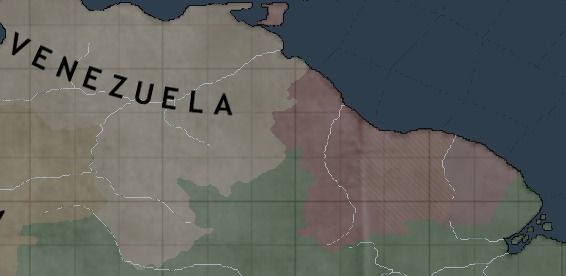
The loss of Surinam.
In East Africa, the Italians had at one point gained the upper hand against the weakened British. Unable to reinforce, the Italians surrendered the initiative to the British. Supported by her allies, the British then steadily overran East Africa during a prolonged campaign. This success was followed with the invasion of the Belgian Congo, from the center of Africa. Much territory was captured, but impassable jungle limited the advance with the result of the Belgians holding onto the Atlantic coast of the colony.

The British advance into the Congo.
In North Africa, the British had fought a back and forth campaign with the Italians. At least two deep incursions were made into Libya, but the Italians were able to counterattack driving the British back. Unwilling to invade Egypt, however, proved the downfall of the Italian African Empire. With imperial forces leading the way, the Italians were driven back to Tripoli and finally defeated. Several attempted Italian amphibious-counterattacks were launched, all briefly retaking Tobruk, but the British buildup in North Africa proved too much for the ill-ventured Italian expeditions.

British propaganda photo of surrendering
Italian forces in North Africa.
These campaigns – in Asia, America, and Africa – had not come cheap. Published records suggest around 60,000 British and Imperial troops were killed in these various campaigns, and the Italians recorded the capture of at least 240,000 men in North Africa during the back and forth fighting. This war against the Italians also included a bloody navy war. While the Italians scored several impressive victories, they could not hold their own against the might of the Royal Navy. The British had reduced the Italian fleet to just 37 ships, and insured the Italians could do little more, to again intervene in Africa. This naval superiority had also inflicted heavy losses upon our own submarine fleet, forcing the Reich to – temporarily – halt attacks on British convoys. The losses suffered in all this fighting, and 1940, had led the Reich intelligence agency to believe there were actually very few troops defending the United Kingdom. It would appear, all that stood between the United Kingdom and their complete and total defeat was the "wooden wall" of the Royal Navy.
During 1940, and the fighting for Western Europe, the British suffered the largest defeat in their military history. With around 700,000 men lost (killed, wounded, or captured), the British Army was effectively forced out of the war with such unsustainable losses.
While the German military went on to campaign in the Balkans and the Soviet Union, the British were left with an aerial offensive as their only option to counter the Reich. Small local successes were scored every now and again – mostly over the skies of Dover, as the Luftwaffe was sucked into dog fighting - but on the whole the Royal Air Force was battered above the skies of France in failed attempts to bomb industrial sites. The largest effort made, apparently in support of the Red Army during the various battles of Operation "Wilhelm", resulted in the loss of hundreds of aircraft for no gain and little damage inflicted upon the German war industry.

Published British propaganda photograph of their troops
in action, in Asia, against the Dutch.
The British, however, bounced back. Supported by her imperial and commonwealth allies, Britain took the war to the allies of the Reich. Following aggressive moves by the Dutch East Indies colonial army, the British mounted a punitive expedition to return the status quo and inflicted series losses upon the Dutch. This was followed by a full-scale invasion of the Dutch South American colonies. The Dutch launched a counterattack, invading British Guiana, but were routed. The better training and quality of the British troops was too much for the Dutch colonial forces, and after a short fight the Dutch colony was overrun with the complete loss of the defending force.

The loss of Surinam.
In East Africa, the Italians had at one point gained the upper hand against the weakened British. Unable to reinforce, the Italians surrendered the initiative to the British. Supported by her allies, the British then steadily overran East Africa during a prolonged campaign. This success was followed with the invasion of the Belgian Congo, from the center of Africa. Much territory was captured, but impassable jungle limited the advance with the result of the Belgians holding onto the Atlantic coast of the colony.

The British advance into the Congo.
In North Africa, the British had fought a back and forth campaign with the Italians. At least two deep incursions were made into Libya, but the Italians were able to counterattack driving the British back. Unwilling to invade Egypt, however, proved the downfall of the Italian African Empire. With imperial forces leading the way, the Italians were driven back to Tripoli and finally defeated. Several attempted Italian amphibious-counterattacks were launched, all briefly retaking Tobruk, but the British buildup in North Africa proved too much for the ill-ventured Italian expeditions.

British propaganda photo of surrendering
Italian forces in North Africa.
These campaigns – in Asia, America, and Africa – had not come cheap. Published records suggest around 60,000 British and Imperial troops were killed in these various campaigns, and the Italians recorded the capture of at least 240,000 men in North Africa during the back and forth fighting. This war against the Italians also included a bloody navy war. While the Italians scored several impressive victories, they could not hold their own against the might of the Royal Navy. The British had reduced the Italian fleet to just 37 ships, and insured the Italians could do little more, to again intervene in Africa. This naval superiority had also inflicted heavy losses upon our own submarine fleet, forcing the Reich to – temporarily – halt attacks on British convoys. The losses suffered in all this fighting, and 1940, had led the Reich intelligence agency to believe there were actually very few troops defending the United Kingdom. It would appear, all that stood between the United Kingdom and their complete and total defeat was the "wooden wall" of the Royal Navy.
Last edited:
The Rebel problem
1942 had provided mixed successes. The USSR had again not been defeated, but advances had been made. The political situation and how the 'liberated' Bolsheviks were being treated, had caused a massive problem. Partisan activity was rampant behind the frontlines. Over 160,000 rebels had been killed in counterinsurgency sweeps during 1942, yet even this horrendous loss of life had not resolved the problem. Large tracts of forest in Belorussia were now in rebel hands. Each day more territory was lost, and more men rallied to the Soviet cause. The security forces, behind Army Group South, had been weakened and were unable to cope with the size and strength of the partisans. Most security forces had been drawn south during 1942, and had yet to return.
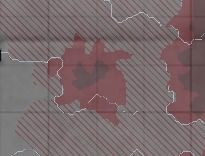
The territory captured by the Belorussian partisans.
In January 1943, changes were implemented. The occupation policies were redrafted to seem less harsh, to attempt – in the long run - to win over the hearts and minds of the ex-Soviet proletariat. For the short term, a new man, more strict than his predecessor, took control of the security forces to put an end to the Belorussian problem. Regular army divisions - forming within the Greater Reich - were ordered to engage the partisans from the west, while the cavalry divisions were to attack from the north and south. Garrison troops would be transferred to block the rebels from attempting to close in on the frontline. Thus, the insurgents would be trapped and crushed within a pocket, attacked from all sides.
While the plan was simple in premise, it was somewhat harder to implement. The 'Russian Winter' was harsher than previous. The temperature and snow caused enormous problems in attempting to get the troops into their forming up positions to commence attacks. In the north, the rebels had successfully halted the first attacks by the northern wing of the encirclement. In the south, partisans were able to keep two cavalry divisions (finally returning from the Ukraine) from crossing vital bridges and getting into the fight. These delays were exacerbated by the thawing snow, which caused the road network to disintegrate resulting in the troops from Germany being unable to deploy successfully.
However, once the three wings had finally formed up, the long term survival of the Belorussian partisan movement vanished. Having taken back the urban centers in the north, forcing the river crossing in the south, and striking from the west, the partisans were set into disarray. Once ambushing from behind every tree, the rebels were forced into open battle and destroyed. It took two months of fighting, and the loss 1,500 soldiers, but by 1 March the Belorussian partisan movement had been wiped out – all 58,000 members. While the rebels had only achieved limited territorial success, they had caused the major strategic effect of delaying the early transfer of troops from north to south and had sucked in reserves that had been destined for the southern part of the front.
1942 had provided mixed successes. The USSR had again not been defeated, but advances had been made. The political situation and how the 'liberated' Bolsheviks were being treated, had caused a massive problem. Partisan activity was rampant behind the frontlines. Over 160,000 rebels had been killed in counterinsurgency sweeps during 1942, yet even this horrendous loss of life had not resolved the problem. Large tracts of forest in Belorussia were now in rebel hands. Each day more territory was lost, and more men rallied to the Soviet cause. The security forces, behind Army Group South, had been weakened and were unable to cope with the size and strength of the partisans. Most security forces had been drawn south during 1942, and had yet to return.

The territory captured by the Belorussian partisans.
In January 1943, changes were implemented. The occupation policies were redrafted to seem less harsh, to attempt – in the long run - to win over the hearts and minds of the ex-Soviet proletariat. For the short term, a new man, more strict than his predecessor, took control of the security forces to put an end to the Belorussian problem. Regular army divisions - forming within the Greater Reich - were ordered to engage the partisans from the west, while the cavalry divisions were to attack from the north and south. Garrison troops would be transferred to block the rebels from attempting to close in on the frontline. Thus, the insurgents would be trapped and crushed within a pocket, attacked from all sides.
While the plan was simple in premise, it was somewhat harder to implement. The 'Russian Winter' was harsher than previous. The temperature and snow caused enormous problems in attempting to get the troops into their forming up positions to commence attacks. In the north, the rebels had successfully halted the first attacks by the northern wing of the encirclement. In the south, partisans were able to keep two cavalry divisions (finally returning from the Ukraine) from crossing vital bridges and getting into the fight. These delays were exacerbated by the thawing snow, which caused the road network to disintegrate resulting in the troops from Germany being unable to deploy successfully.
However, once the three wings had finally formed up, the long term survival of the Belorussian partisan movement vanished. Having taken back the urban centers in the north, forcing the river crossing in the south, and striking from the west, the partisans were set into disarray. Once ambushing from behind every tree, the rebels were forced into open battle and destroyed. It took two months of fighting, and the loss 1,500 soldiers, but by 1 March the Belorussian partisan movement had been wiped out – all 58,000 members. While the rebels had only achieved limited territorial success, they had caused the major strategic effect of delaying the early transfer of troops from north to south and had sucked in reserves that had been destined for the southern part of the front.
Last edited:
Damn partisans! I hate it when they pop up their nasty heads. What is your makeup of your garrison / cavalry security divisions? Ny MP brigades mixed in?
I am using the HPP mod so there are no longer MP brigades (am pretty sure at least!). My garrison divisions vary. I have a bunch that are just 2 brigades strong, and I have a few that contain a support brigade. My cavalry divisions likewise vary between 2-3 brigades strong.
Fighting in the north
The initial plan for 1943 called for the northern front to be thinned out and troops transferred south for an upcoming offensive in the Ukraine. The partisan problem meant that the troops could not be redeployed for fear of Soviet attacks to link up with them, and if the troops were transferred – moving around partisan held country - there may not be enough men to actually combat the insurgents. Therefore, while efforts were made to combat the rebels, Army Group North would tidy up the loose ends of 1942 by continuing operations to push the frontline forward towards the limited goal of Operation "Hindenburg": Narva.
To free up forces later, all remaining garrison divisions within the Greater Reich and Denmark were ordered to dispatch one brigade to the Eastern Front, while several divisions were transferred from Belgium and the Netherlands to the frontline. This transfer of troops resulted in there now being over 200 infantry divisions on the order of battle, an increasing amount having less than 7,000 men.
The conditions, in which the men found themselves in, were appalling. The temperatures were below freezing and snow was falling constantly. Soviet forces were well entrenched holding the approaches to Narva, meaning every step of ground would have a steep price tag. The only weak section of the front was the island of Saaremaa, were a single demoralized and cut off Red Army division was dug in. In blizzard conditions, the 22nd Panzer Division had attempted to size the island via coup de main, but with limited assault craft the panzergrendiers were easily repulsed by the down spirited Red Army troopers. It was therefore decided to bombard the island while waiting on pioneers and regular infantry to arrive and take up the assault. The fighting and weather had practically destroyed the Estonian road network and the reinforcements took quite some time to arrive. By the end of January, the men had finally moved into position and quickly launched their assault. Landing at numerous points across the island, the infantry quickly rounded up the defenders who were unwilling to fight, although the final soldiers did not surrender until 8 February.
As February moved into March, heavy rains broke across the length of the northern front and the snow melted. The road network, already heavily damaged, disintegrated. Infantry had to fight through extremely deep mud, making combat nearly impossible. Yet the men were ordered forward to attack the Soviet defensive positions. Soaked, covered in mud, supporting artillery not effective due the rounds exploding in the mud, and exhausted, day after they day they assaulted collapsing trenches and holes clawed out of the soggy ground. Against all expectations, they were able to advance. Steadily the Red Army was pushed back creating a pocket in northern Estonia holding an estimated 45,000 soldiers. This became the target of focus; crush the pocket, free up troops and push forward once more for Narva. On 19 March, the pocket finally fell with a haul of over 40,000 men.
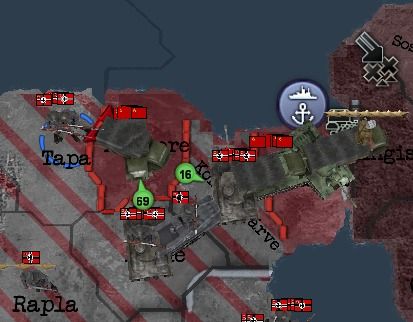
The pocket in northern Estonia.
There was no time to be exalted, even at this small triumph, as 24 hours previously the Soviets launched an offensive to the east of Lake Peipus. Wave after wave of Soviet soldiers pushed their way through the mud and assaulted two airborne divisions holding an important corner of the front. The initial waves were thrown back, but the Red Army infantry kept up their assault by striking another area in this sector. Troops who were about to be transferred south, were instead moved in behind this sector of Army Group North’s front. The Soviets, once more, had sucked in our reserves before we could redeploy. The Red Army managed to breakthrough, but the redeployed troops arrived just in time to push them back and restore the integrity of the line. Further attacks were launched on the paratroops, who were forced back, and more troops had to be rushed into the area to prevent a Soviet breakthrough.
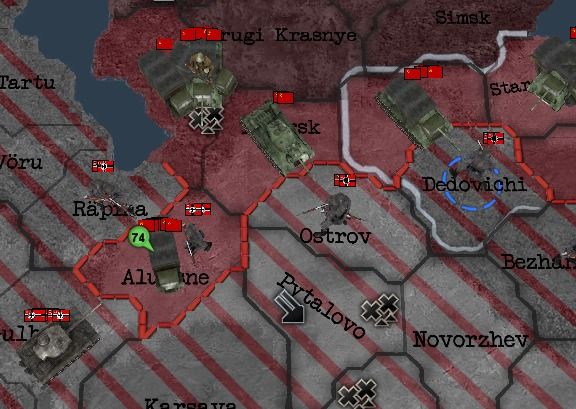
The initial Soviet breakthrough.
While the frontline had been pushed back in one area, enough troops had been brought into the line to stabilize the rest. The Soviet offensive had been halted and thrown back with heavy losses. With so many troops in the area, it was decided to launch our own attack. The attack would not retake the ground lost, but rather trade lost territory for new pastures. The focus of the fighting now centered on the fortress at Pskov. While the temperatures may have warmed up, the front was still a quagmire of mud. Even so, our forces were able to push back the Red Army and advance north taking territory to the east of the fort. With this ground won, attacks were then launched on the fort from numerous directions. Over the following weeks the fortress would be largely destroyed in the fighting. Hundreds of thousands of rounds of artillery shells plunged into the fortress, as assault after assault was made to take the fort. At times the Red Army were barely holding on, but were able to bring up just enough reinforcements to halt the latest attack. However, the pool of reinforcements eventually dried up and our troops pushed forward to occupy the shell-scarred battlefield.
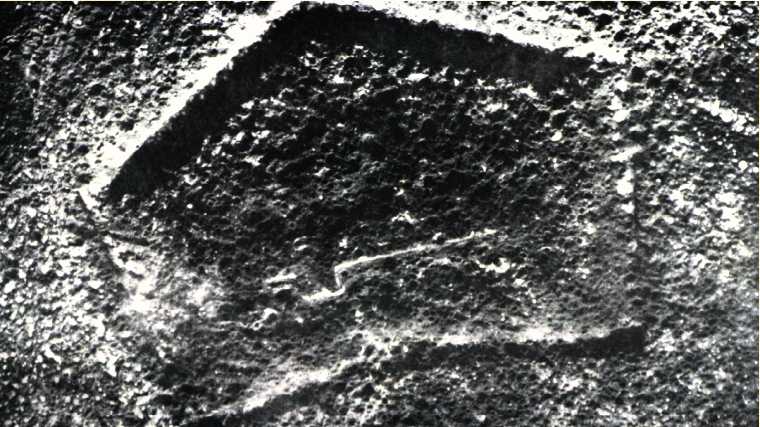
The fortress of Pskov, following the battle.
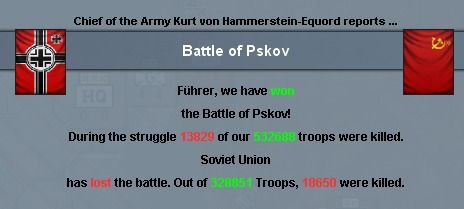
The price of victory.
As the Soviet offensive and the Battle of Pskov were being conducted, the final battles for Narva were taking place. Across near impossible terrain, German infantry conducted the Battle of Rakvere. The tanks were unable to get forward, trucks were bogged down, and the infantry were killed by the squad-load as the battle ran on. With the Red Army committed to the fighting at Pskov, and being engaged to the east of the fort as well, few reinforcements were available for the north. The Red Army held on, fighting tooth and nail, but eventually was simply overwhelmed by numbers and firepower. Close to 20,000 German infantry were killed in the battle and only 10,000 Red Army bodies were found afterwards. As the ground dried out, the panzers and the Grossdeutschland Division were able to rush forward overtaking numerous Soviet units and capturing Narva on 23 March.

"General Mud" dictated quite a portion of the battle.
The battles along the northern front had resulted in the loss of 85,376 men. The most shocking event, kept secret from the public, was the loss of the surface fleet. It had been deployed to aid the battles in Northern Estonia, by shelling Soviet positions, and had been sunk by Soviet bombers. The Schleswig-Holstein, Graf Spee, Deutschland, Konigsberg, Leipzig, Nurnberg, Koln, Karlsruhe, and three destroyers had been lost along with 2,700 sailors. These losses were somewhat offset by the defeat inflicted on the Red Army. 98,389 men had been killed, and officially 51,960 prisoners taken. The rapid advance into Narva had saw several Red Army units overrun, and their fate was not known: did they escape to Soviet lines?
The initial plan for 1943 called for the northern front to be thinned out and troops transferred south for an upcoming offensive in the Ukraine. The partisan problem meant that the troops could not be redeployed for fear of Soviet attacks to link up with them, and if the troops were transferred – moving around partisan held country - there may not be enough men to actually combat the insurgents. Therefore, while efforts were made to combat the rebels, Army Group North would tidy up the loose ends of 1942 by continuing operations to push the frontline forward towards the limited goal of Operation "Hindenburg": Narva.
To free up forces later, all remaining garrison divisions within the Greater Reich and Denmark were ordered to dispatch one brigade to the Eastern Front, while several divisions were transferred from Belgium and the Netherlands to the frontline. This transfer of troops resulted in there now being over 200 infantry divisions on the order of battle, an increasing amount having less than 7,000 men.
The conditions, in which the men found themselves in, were appalling. The temperatures were below freezing and snow was falling constantly. Soviet forces were well entrenched holding the approaches to Narva, meaning every step of ground would have a steep price tag. The only weak section of the front was the island of Saaremaa, were a single demoralized and cut off Red Army division was dug in. In blizzard conditions, the 22nd Panzer Division had attempted to size the island via coup de main, but with limited assault craft the panzergrendiers were easily repulsed by the down spirited Red Army troopers. It was therefore decided to bombard the island while waiting on pioneers and regular infantry to arrive and take up the assault. The fighting and weather had practically destroyed the Estonian road network and the reinforcements took quite some time to arrive. By the end of January, the men had finally moved into position and quickly launched their assault. Landing at numerous points across the island, the infantry quickly rounded up the defenders who were unwilling to fight, although the final soldiers did not surrender until 8 February.
As February moved into March, heavy rains broke across the length of the northern front and the snow melted. The road network, already heavily damaged, disintegrated. Infantry had to fight through extremely deep mud, making combat nearly impossible. Yet the men were ordered forward to attack the Soviet defensive positions. Soaked, covered in mud, supporting artillery not effective due the rounds exploding in the mud, and exhausted, day after they day they assaulted collapsing trenches and holes clawed out of the soggy ground. Against all expectations, they were able to advance. Steadily the Red Army was pushed back creating a pocket in northern Estonia holding an estimated 45,000 soldiers. This became the target of focus; crush the pocket, free up troops and push forward once more for Narva. On 19 March, the pocket finally fell with a haul of over 40,000 men.

The pocket in northern Estonia.
There was no time to be exalted, even at this small triumph, as 24 hours previously the Soviets launched an offensive to the east of Lake Peipus. Wave after wave of Soviet soldiers pushed their way through the mud and assaulted two airborne divisions holding an important corner of the front. The initial waves were thrown back, but the Red Army infantry kept up their assault by striking another area in this sector. Troops who were about to be transferred south, were instead moved in behind this sector of Army Group North’s front. The Soviets, once more, had sucked in our reserves before we could redeploy. The Red Army managed to breakthrough, but the redeployed troops arrived just in time to push them back and restore the integrity of the line. Further attacks were launched on the paratroops, who were forced back, and more troops had to be rushed into the area to prevent a Soviet breakthrough.

The initial Soviet breakthrough.
While the frontline had been pushed back in one area, enough troops had been brought into the line to stabilize the rest. The Soviet offensive had been halted and thrown back with heavy losses. With so many troops in the area, it was decided to launch our own attack. The attack would not retake the ground lost, but rather trade lost territory for new pastures. The focus of the fighting now centered on the fortress at Pskov. While the temperatures may have warmed up, the front was still a quagmire of mud. Even so, our forces were able to push back the Red Army and advance north taking territory to the east of the fort. With this ground won, attacks were then launched on the fort from numerous directions. Over the following weeks the fortress would be largely destroyed in the fighting. Hundreds of thousands of rounds of artillery shells plunged into the fortress, as assault after assault was made to take the fort. At times the Red Army were barely holding on, but were able to bring up just enough reinforcements to halt the latest attack. However, the pool of reinforcements eventually dried up and our troops pushed forward to occupy the shell-scarred battlefield.

The fortress of Pskov, following the battle.

The price of victory.
As the Soviet offensive and the Battle of Pskov were being conducted, the final battles for Narva were taking place. Across near impossible terrain, German infantry conducted the Battle of Rakvere. The tanks were unable to get forward, trucks were bogged down, and the infantry were killed by the squad-load as the battle ran on. With the Red Army committed to the fighting at Pskov, and being engaged to the east of the fort as well, few reinforcements were available for the north. The Red Army held on, fighting tooth and nail, but eventually was simply overwhelmed by numbers and firepower. Close to 20,000 German infantry were killed in the battle and only 10,000 Red Army bodies were found afterwards. As the ground dried out, the panzers and the Grossdeutschland Division were able to rush forward overtaking numerous Soviet units and capturing Narva on 23 March.

"General Mud" dictated quite a portion of the battle.
The battles along the northern front had resulted in the loss of 85,376 men. The most shocking event, kept secret from the public, was the loss of the surface fleet. It had been deployed to aid the battles in Northern Estonia, by shelling Soviet positions, and had been sunk by Soviet bombers. The Schleswig-Holstein, Graf Spee, Deutschland, Konigsberg, Leipzig, Nurnberg, Koln, Karlsruhe, and three destroyers had been lost along with 2,700 sailors. These losses were somewhat offset by the defeat inflicted on the Red Army. 98,389 men had been killed, and officially 51,960 prisoners taken. The rapid advance into Narva had saw several Red Army units overrun, and their fate was not known: did they escape to Soviet lines?
Last edited:
The Third Battle of Odessa (24 January – 22 March)
Originally, the Soviet holdouts in Odessa were going to be left until spring. The bad weather would have passed, and reinforcements from the north would have arrived. The Soviets, however, interfered with these well laid out plans. As the major counter-insurgent operation was taking place in the north, several thousand rebels made themselves known in the south. Their emergence was deemed to be part of a Soviet effort to link up with the besieged soldiers of the Odessa garrison. As rebels attempted to take control of key points on the road network between the frontline, a Soviet offensive was launched aimed at linking up with the rebels, and the Odessa garrison launched a breakout in the same general direction.
The insurgent attack was quickly crushed by the timely arrival of a panzer division, and the Soviet thrust from their frontline was parried. Around Odessa, the battle yet raged. The Soviet attack was met by our own counterattacks, but after several days of fighting peace returned to the battlefield. Army Group South Ukraine was content that the Soviet breakout had been prevented, and the Soviets content that Odessa had been held. It quickly became clear, that while no major formations had been shipped into the pocket, drafts of reinforcements were being ferried in to make up for the Red Army losses.
During February, the Red Army launched a number of minor attacks against our forces. Small-scale raiding took place, the Soviets probing our defenses to see what force had been arrayed against the besieged troops. These small raids built-up, the attacks intensified and in turn were met with retaliation. A major attack was launched against the east side of the city to draw off forces while a massive assault was made to take the fortress of Illichivsk, guarding the western flank of the city. For most of the month back and forth fighting took place. At times it seemed success was within sight, only to be bayonetted by Red Army counterattacks. The snow (which quickly melted) and mud took most out of the men, and divisions were rotated in and out of the battle on a regular basis. Yet even this, which the Red Army could not match, was unable to take the entrenched Soviet positions. Exhausted, and having lost 15,000 men during the month, the attacks were called off.
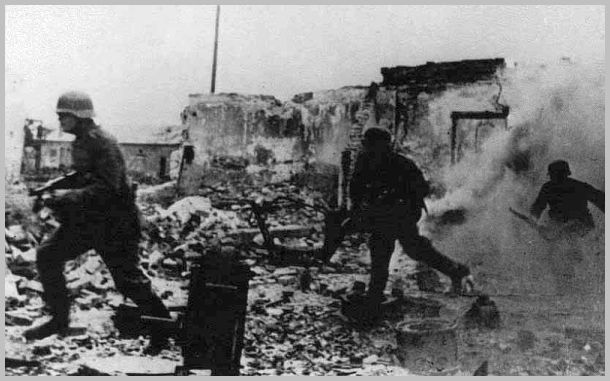
Infantry push through smashed buildings near the fortress of Illichivsk.
While the back and forth fighting took place, several new divisions were transferred to the front. As the February fighting came to an end, several fresh divisions were ready. With the partisan problem in the north solved, and the Soviet counterattacks in the north parried, Army Group South Ukraine was now coming under pressure to solve the Odessa problem before the new campaign season. With that in mind, the fresh divisions were launched into battle to take Illichivsk. Previously, both the fortress and the city had been attacked and it had resulted in failure with our forces spread too thin. With the fortress the sole goal, this Red Army bastion could now be attacked from multiple sides while a smaller force kept the Odessa garrison pinned down. The stratagem worked. The stronghold, under heavy pressure, fell in early March.
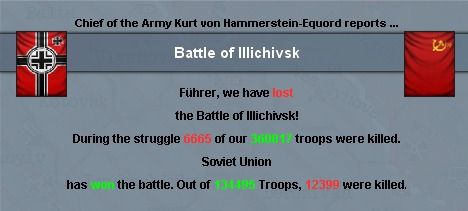
The casualty toll for the final battle for the fort.
For the first time, Odessa could now be attacked from all sides. The follow-up attack was launched immediately, and the city garrison was unable to do much to stem the tide of the German assault. On 22 March, after holding out for five months, the garrison surrendered. It had been estimated that 150,000 Red Army troops had been surrounded in Odessa, but when the final tally, of those captured, had been completed, 289,665 soldiers had been taken prisoner. The final three months of the siege had resulted in 28,666 German deaths, and the loss of 50,052 Soviets. Operation Paradox had thus encircled at least 350,000 men inside the small perimeter of the city and the fortress.
Originally, the Soviet holdouts in Odessa were going to be left until spring. The bad weather would have passed, and reinforcements from the north would have arrived. The Soviets, however, interfered with these well laid out plans. As the major counter-insurgent operation was taking place in the north, several thousand rebels made themselves known in the south. Their emergence was deemed to be part of a Soviet effort to link up with the besieged soldiers of the Odessa garrison. As rebels attempted to take control of key points on the road network between the frontline, a Soviet offensive was launched aimed at linking up with the rebels, and the Odessa garrison launched a breakout in the same general direction.
The insurgent attack was quickly crushed by the timely arrival of a panzer division, and the Soviet thrust from their frontline was parried. Around Odessa, the battle yet raged. The Soviet attack was met by our own counterattacks, but after several days of fighting peace returned to the battlefield. Army Group South Ukraine was content that the Soviet breakout had been prevented, and the Soviets content that Odessa had been held. It quickly became clear, that while no major formations had been shipped into the pocket, drafts of reinforcements were being ferried in to make up for the Red Army losses.
During February, the Red Army launched a number of minor attacks against our forces. Small-scale raiding took place, the Soviets probing our defenses to see what force had been arrayed against the besieged troops. These small raids built-up, the attacks intensified and in turn were met with retaliation. A major attack was launched against the east side of the city to draw off forces while a massive assault was made to take the fortress of Illichivsk, guarding the western flank of the city. For most of the month back and forth fighting took place. At times it seemed success was within sight, only to be bayonetted by Red Army counterattacks. The snow (which quickly melted) and mud took most out of the men, and divisions were rotated in and out of the battle on a regular basis. Yet even this, which the Red Army could not match, was unable to take the entrenched Soviet positions. Exhausted, and having lost 15,000 men during the month, the attacks were called off.

Infantry push through smashed buildings near the fortress of Illichivsk.
While the back and forth fighting took place, several new divisions were transferred to the front. As the February fighting came to an end, several fresh divisions were ready. With the partisan problem in the north solved, and the Soviet counterattacks in the north parried, Army Group South Ukraine was now coming under pressure to solve the Odessa problem before the new campaign season. With that in mind, the fresh divisions were launched into battle to take Illichivsk. Previously, both the fortress and the city had been attacked and it had resulted in failure with our forces spread too thin. With the fortress the sole goal, this Red Army bastion could now be attacked from multiple sides while a smaller force kept the Odessa garrison pinned down. The stratagem worked. The stronghold, under heavy pressure, fell in early March.

The casualty toll for the final battle for the fort.
For the first time, Odessa could now be attacked from all sides. The follow-up attack was launched immediately, and the city garrison was unable to do much to stem the tide of the German assault. On 22 March, after holding out for five months, the garrison surrendered. It had been estimated that 150,000 Red Army troops had been surrounded in Odessa, but when the final tally, of those captured, had been completed, 289,665 soldiers had been taken prisoner. The final three months of the siege had resulted in 28,666 German deaths, and the loss of 50,052 Soviets. Operation Paradox had thus encircled at least 350,000 men inside the small perimeter of the city and the fortress.
Last edited:
World War
While on the Eastern Front, following the victories in the north and south, the military started the slow process of rebuilding the frontline and reinforcing heavily depleted divisions, the diplomatic situation moved at lightning speed over the following weeks.
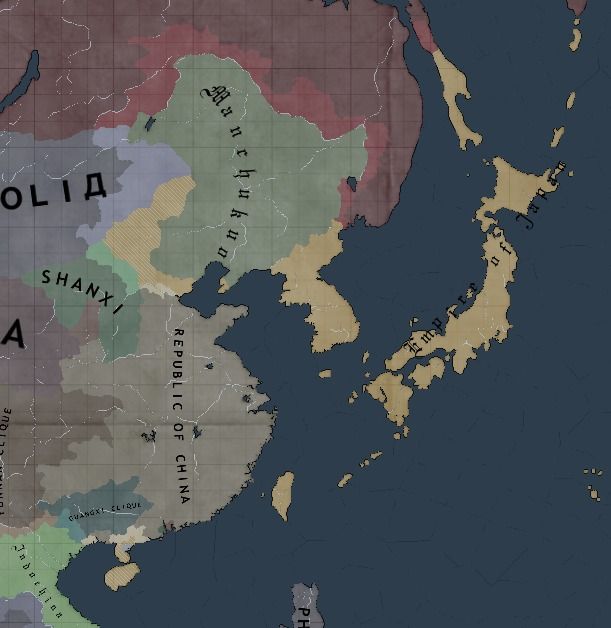
The Far East, April 1943
Looking to force the hand of the Soviets, by providing a new strategic threat that would require them to deploy forces, the German government looked to Asia for possible allies. Germany and China had a long history of close co-operation, and the possibility existed to formally ally the two nations. The nationalist government of China was, after all, at war with communists insurgents. However, due to years of internal conflict the nationalist government lacked a common border with the Soviets, therefore any formal alliance would have been of no benefit. Therefore, an invitation was sent to the Japanese and, on 25 April, the Tripartite Pact was signed. Several days later, the Japan and the French State concluded an agreement allowing Japan to take control of French Indochina to "protect it from the British".

With Japan now a member of the Axis, the Republic of China joined the Allies. Manchukuo, Thailand, and Indochina then proceeded to sign the Anti-Comintern Pact. The Japanese, having already gained several diplomatic victories over the preceding days, then put pressure of Siam to allow Japanese troops to move through their territory. On 3 May, Japan initiated small scale landings in the Dutch East Indies. The Dutch resisted, repelling the first wave of Japanese marines inflicting a few hundred casualties. As a member of the Axis, the Dutch were protected by her fellow allies, and thus the Axis went to war with Japan. The Japanese halted their invasion attempt, but their actions had resulted in a messy situation in Asia. The Asiatic members of the Axis alliance, and those aligned with Japan, now went to war with each other: Indochinese troops attacked Thailand and vice-versa. The British position in the east was not as delicate as in the west, and within a few months had organized an invasion of southern Thailand via Malaya, while the British Indian Army marched across the western border from the jungles of Burma.
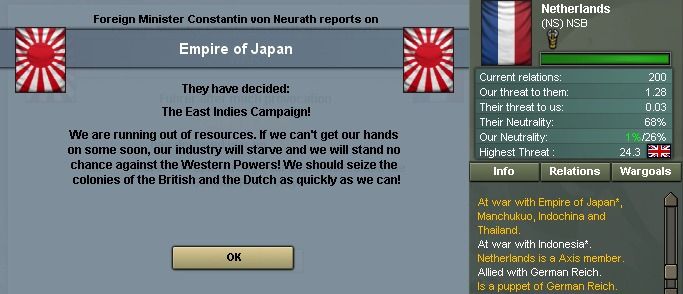
The Japanese, unconcerned with the fact they had initiated a world war against themselves, proceeded to launch their most daring move to date. At midday, Pacific Time on the 4 May, 353 fighters, bombers and torpedo planes – in two waves and launched from six aircraft carriers – attacked the American fleet at Pearl Harbor. The Japanese proclaimed that they had sunk the entire American Pacific Fleet, but the American press was quiet on the actual damage inflicted.
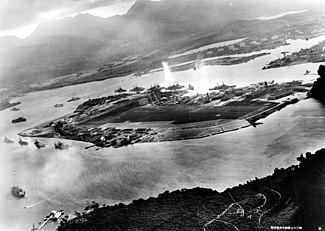
Released Japanese propaganda photo showing the attack on the American fleet.
The American response was mixed. The following day the German ambassador in Washington D.C. met with the American State Department. Informing the Americans of German’s deep regret that the Japanese had launched such an attack, and reassuring them that Germany was now at war with Japan and did not see the alliance of 25 April as valid, the Americans proceeded to sign the Anti-Comintern Treaty. The ambassador and his American counterparts then discussed the possibility of the Americans joining the Axis alliance, but no formal decisions were made. Returning to the embassy, our ambassador was confident he had avoided war between our two nations. Meanwhile, on the same day in Berlin the American ambassador informed our government that trade between our nations was no longer possible and that America had allied herself with the United Kingdom and was thus at war with Germany. With trade cut and our American friends stabbing us in the back, the U-Boat fleet was ordered to set sail to sink any ship sighted in the Atlantic Ocean. Numerous divisions were also given orders to transfer off the frontline and deploy to Gaul to keep the Americans from interfering in Europe.

On 6 May, the Americans announced the formation of the United Nations. The various members of the Allied bloc all quickly subscribe to this ideal. During the rest of the month Shanxi, El Salvador, and the Guangxi Clique all sent representatives to sign the anti-Comintern treaty. While the members of the actual Axis bloc was small, the list of nations wanting to fight international communism continued to grow.

On 22 May, the United States announced its intention to land in North Africa to aid the British. The British had once again had to fight off an attempted Italian landing in Tobruk, and the Americans sought to gain full control of the North African shoreline to halt further Italian imperial measures. In turn, the French State informed Germany of the American intentions, and the French were offered our protection. The Americans thus dragged France back into the war, this time allied to Germany. The next day the French also signed the anti-comintern treaty.
While on the Eastern Front, following the victories in the north and south, the military started the slow process of rebuilding the frontline and reinforcing heavily depleted divisions, the diplomatic situation moved at lightning speed over the following weeks.

The Far East, April 1943
Looking to force the hand of the Soviets, by providing a new strategic threat that would require them to deploy forces, the German government looked to Asia for possible allies. Germany and China had a long history of close co-operation, and the possibility existed to formally ally the two nations. The nationalist government of China was, after all, at war with communists insurgents. However, due to years of internal conflict the nationalist government lacked a common border with the Soviets, therefore any formal alliance would have been of no benefit. Therefore, an invitation was sent to the Japanese and, on 25 April, the Tripartite Pact was signed. Several days later, the Japan and the French State concluded an agreement allowing Japan to take control of French Indochina to "protect it from the British".

With Japan now a member of the Axis, the Republic of China joined the Allies. Manchukuo, Thailand, and Indochina then proceeded to sign the Anti-Comintern Pact. The Japanese, having already gained several diplomatic victories over the preceding days, then put pressure of Siam to allow Japanese troops to move through their territory. On 3 May, Japan initiated small scale landings in the Dutch East Indies. The Dutch resisted, repelling the first wave of Japanese marines inflicting a few hundred casualties. As a member of the Axis, the Dutch were protected by her fellow allies, and thus the Axis went to war with Japan. The Japanese halted their invasion attempt, but their actions had resulted in a messy situation in Asia. The Asiatic members of the Axis alliance, and those aligned with Japan, now went to war with each other: Indochinese troops attacked Thailand and vice-versa. The British position in the east was not as delicate as in the west, and within a few months had organized an invasion of southern Thailand via Malaya, while the British Indian Army marched across the western border from the jungles of Burma.

The Japanese, unconcerned with the fact they had initiated a world war against themselves, proceeded to launch their most daring move to date. At midday, Pacific Time on the 4 May, 353 fighters, bombers and torpedo planes – in two waves and launched from six aircraft carriers – attacked the American fleet at Pearl Harbor. The Japanese proclaimed that they had sunk the entire American Pacific Fleet, but the American press was quiet on the actual damage inflicted.

Released Japanese propaganda photo showing the attack on the American fleet.
The American response was mixed. The following day the German ambassador in Washington D.C. met with the American State Department. Informing the Americans of German’s deep regret that the Japanese had launched such an attack, and reassuring them that Germany was now at war with Japan and did not see the alliance of 25 April as valid, the Americans proceeded to sign the Anti-Comintern Treaty. The ambassador and his American counterparts then discussed the possibility of the Americans joining the Axis alliance, but no formal decisions were made. Returning to the embassy, our ambassador was confident he had avoided war between our two nations. Meanwhile, on the same day in Berlin the American ambassador informed our government that trade between our nations was no longer possible and that America had allied herself with the United Kingdom and was thus at war with Germany. With trade cut and our American friends stabbing us in the back, the U-Boat fleet was ordered to set sail to sink any ship sighted in the Atlantic Ocean. Numerous divisions were also given orders to transfer off the frontline and deploy to Gaul to keep the Americans from interfering in Europe.

On 6 May, the Americans announced the formation of the United Nations. The various members of the Allied bloc all quickly subscribe to this ideal. During the rest of the month Shanxi, El Salvador, and the Guangxi Clique all sent representatives to sign the anti-Comintern treaty. While the members of the actual Axis bloc was small, the list of nations wanting to fight international communism continued to grow.

On 22 May, the United States announced its intention to land in North Africa to aid the British. The British had once again had to fight off an attempted Italian landing in Tobruk, and the Americans sought to gain full control of the North African shoreline to halt further Italian imperial measures. In turn, the French State informed Germany of the American intentions, and the French were offered our protection. The Americans thus dragged France back into the war, this time allied to Germany. The next day the French also signed the anti-comintern treaty.
Last edited:

